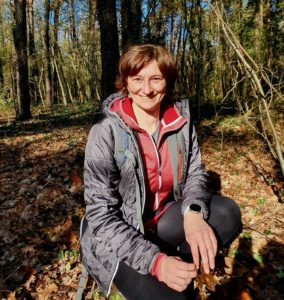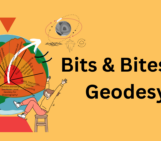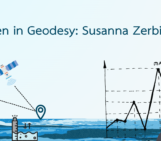
Now that you know who the new ECS Reps are. Who else is part of the Geodesy Division Team? The outgoing president Johannes Böhm did an excellent job for the last four years. Now Annette Eicker has taken over in April as she was elected as the new president of the Geodesy Division. But who is Annette? We asked her a few questions about her work within the EGU, but also about her research and what she is doing, when she is not sitting behind a screen. Read below to find out more.
What are your respon sibilities within the Division?
sibilities within the Division?
As member of the EGU Programme Committee I am responsible for organizing the geodesy programme for the EGU General Assembly in close cooperation with the session conveners. Apart from this mostly organizational work, EGU offers a variety of opportunities to get involved. I hope that our Division Team can help to increase the visibility of geodesy among other disciplines, e.g. by jointly organizing cross-division sessions and by initiating short courses. Another valuable aspect is to foster the community feeling within our division. So undoubtedly the most important task will be to keep up our recently established Geodesy Reception in Vienna. 🙂
How was your first EGU GA as Division President?
Definitely a lot more exciting (or should I rather say stressful?) than I would have hoped for. The technical problems at the beginning of the second week required lots of communication between the Programme Committee, the conference organizers at Copernicus and the conveners of our sessions. So, I have to admit that I was rather relieved after the two weeks were over. On the other hand, it was amazing to see and actually talk to so many colleagues and to experience how much exciting science can be shared even in an online-only format.
What was your motivation to run for election for the position of Division President?
I had been involved in the division team for quite some time as Science Officer and Deputy President and I had a lot of fun working together in our division team. And since Johannes had to step down after four years, I decided that I would like to continue what we had started and get a bit stronger involved with EGU.
What is the most exciting part of this job for you?
I have only just started a few weeks ago, so maybe it’s a bit too early to tell. But what has already been very interesting is to get a glimpse behind the scenes of how EGU works: experiencing the cooperation within the EGU Programme Committee and the EGU Council, gaining insight in how such a big conference is run, and learning about EGU’s bottom-up structure and the possibilities this might open. It has also been nice to get to know many new people from various other divisions (well, as far as “getting to know” is even possible if you can only meet via little Zoom rectangles).
Give us a quick overview of your professional career so far!
I have spent large parts of my scientific life at the University of Bonn (Germany), were I got my PhD in 2008 and continued to work for some years as a postdoc. This time was interrupted by two fantastic research stays at the University of Rennes (France) and at NASA’s Jet Propulsion Laboratory in California. Since 2016 I have been professor for “Geodesy and Adjustment Theory” at HafenCity University in Hamburg.
Currently, what are your research topics?
I have been studying satellite gravity data since the beginning of my PhD. While I personally spend way too much time on administration and teaching at the moment, together with my group of PhD students I am currently working on the application of GRACE data in hydrology and climate science. We try to squeeze as much temporally high-frequent gravity field information as possible out of daily GRACE data for studying atmospheric water fluxes and for combining it with soil moisture observations. Furthermore, we use gravity data in combination with groundwater data for the improvement of hydrological models and investigate ways to use GRACE for evaluating climate models.
Apart from scientific exchange, what is the most important aspect of EGU to you?
Definitely meeting the “geodesy family” including many long-standing colleagues and friends.
Do you have any hidden talents or hobbies?
Nope, no hidden talents. But in my free time I enjoy doing all kind of outdoorsy things. I have a passion for mountain biking, but I have to admit that my bike has been rather disappointed with me after I moved to Hamburg: not really any mountains in Northern Germany and thus I have largely replaced it by a road bike.
Where are you going for your first holiday after the pandemic is over?
Nothing planned, yet. But maybe I can bring myself and my sad mountain bike (see above) finally a bit closer to the real mountains again?
Do you have a favourite place in Vienna?
Since our first Geodesy Reception I have fallen in love with the balcony at TUtheSky and the view you have from there. I sure hope I will get the chance to meet everyone up there again next April to share a glass of wine or whatever else you like!
We hope that you have enjoyed learning more about our new Geodesy Division President. Within the coming weeks, you will able to get to know more members of the Geodesy Division Team.




